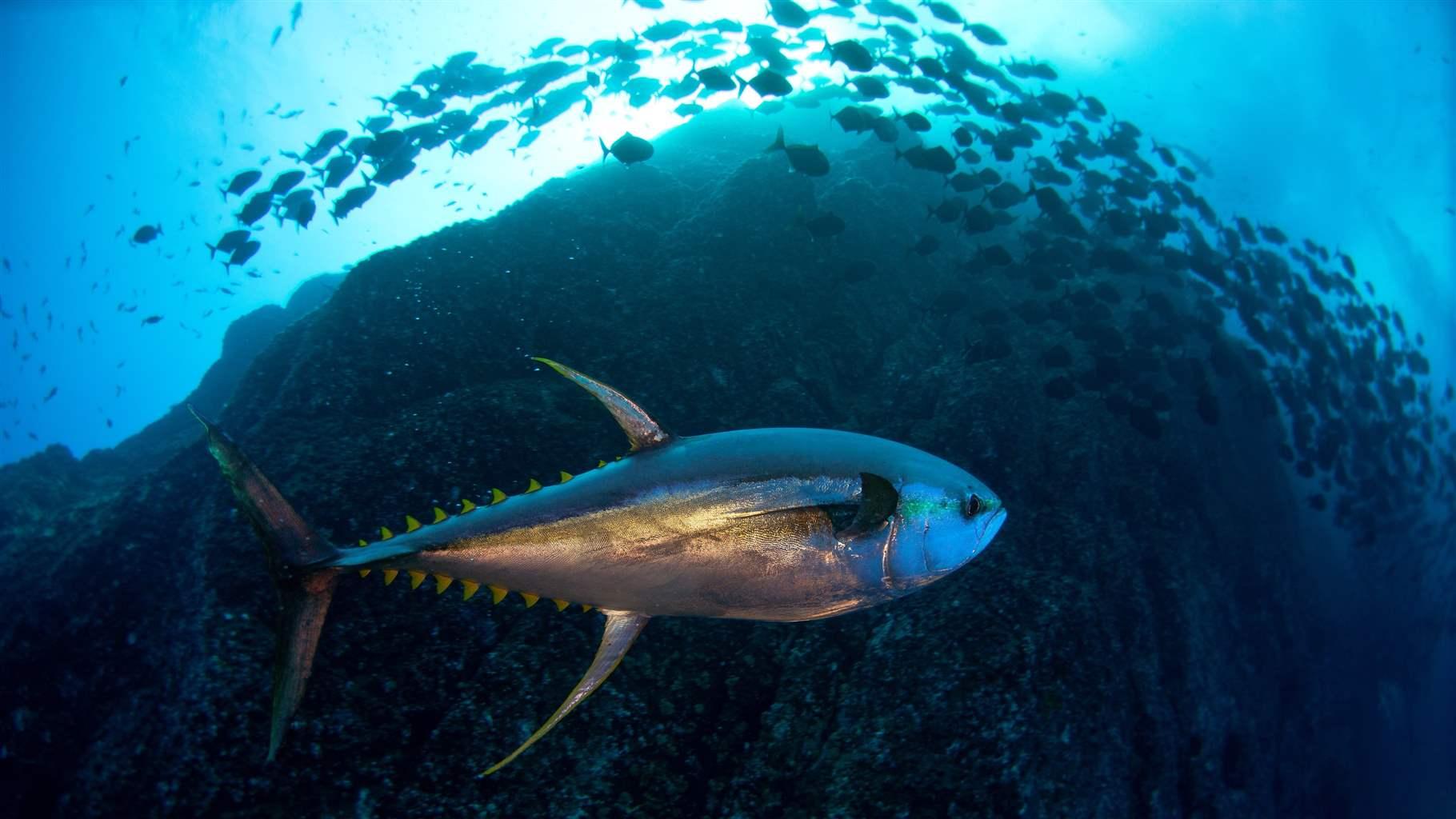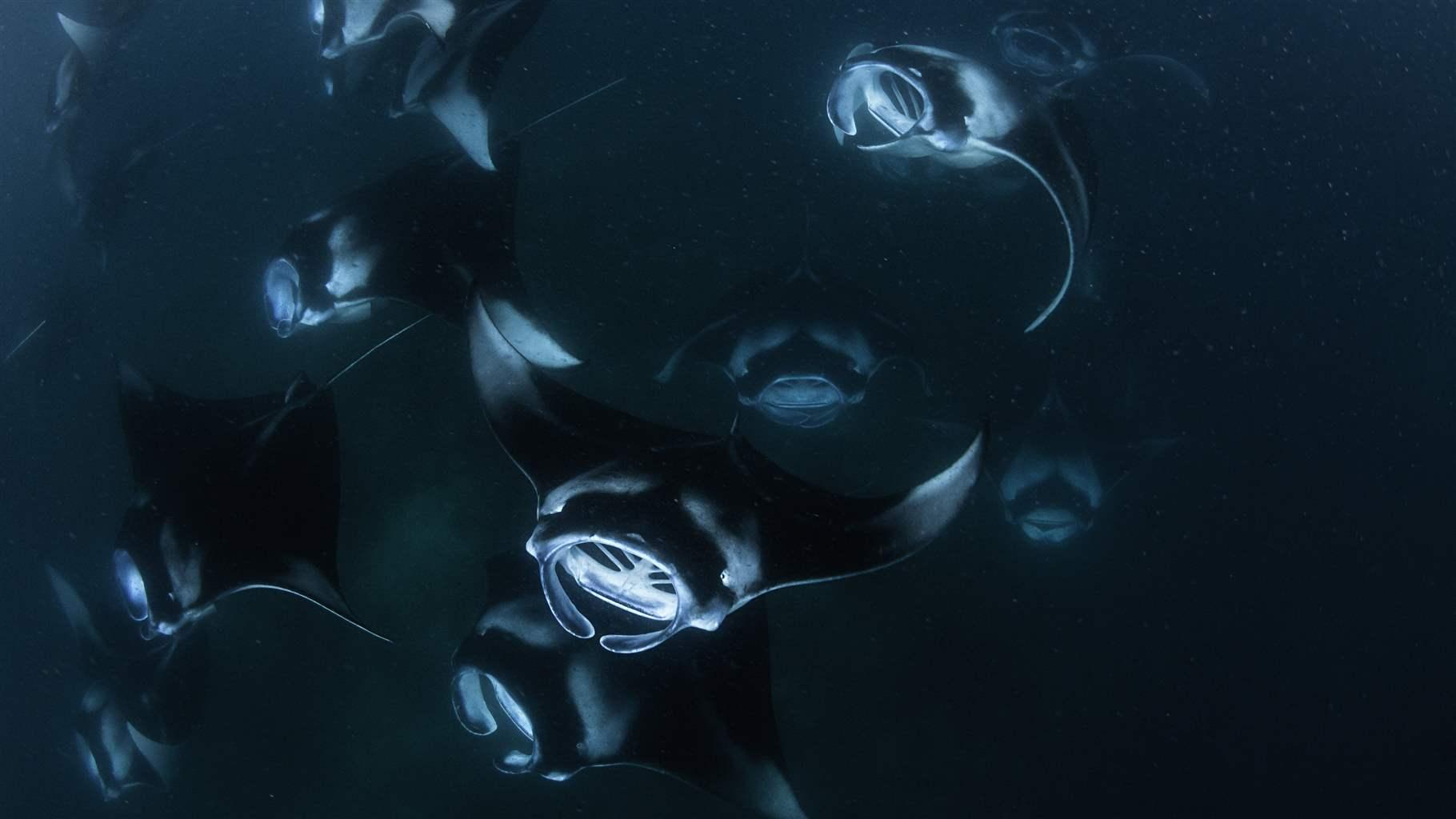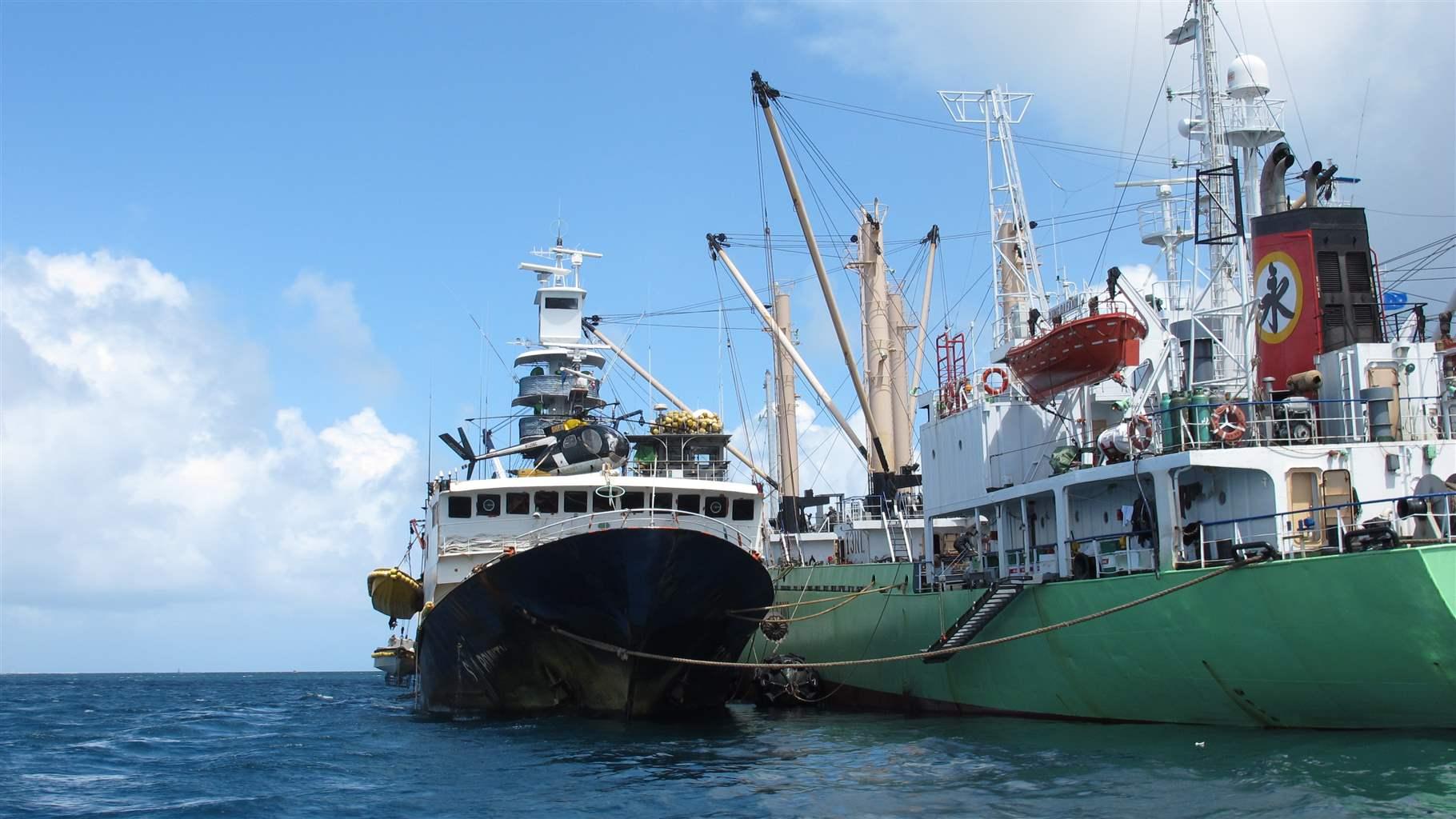A Checklist for Fisheries Management in the Western and Central Pacific
Managers must conserve tunas and sharks, reform transshipment, and end illegal fishing

Overview
The Western and Central Pacific Fisheries Commission (WCPFC) is responsible for the long-term conservation and management of highly migratory fish stocks, including tunas and sharks, in the western and central Pacific Ocean. The Pew Charitable Trusts calls on the Commission to fulfil this responsibility by taking the following actions at its 16th annual meeting from 5-11 December in Port Moresby, Papua New Guinea.
Advance the creation of harvest strategies to support sustainable fisheries
WCPFC has made considerable progress in developing harvest strategies for tunas in accordance with conservation and management measure (CMM) 2014-06 and its harvest strategy workplan.
At this meeting, the Commission should:
- Adopt terms of reference for creating a Harvest Strategy Development Working Group to facilitate interaction between scientists, managers, and other parties.
- Dedicate adequate funding to advance the management strategy evaluation (MSE) processes for skipjack, South Pacific albacore, yellowfin, and bigeye tunas.
- Provide feedback on the initial results of the skipjack MSE, including candidate harvest control rules.
- Adopt interim target reference points (TRPs) for bigeye and yellowfin tunas at their current levels of biomass until the necessary data and analyses are available to factor in socioeconomic objectives. Setting TRPs at current biomass levels would achieve the objectives of CMM 2018-01 to prevent biomass decline.
- Require at least a 70 per cent chance of meeting these interim TRPs to ensure that the populations achieve them more often than not.
- Adopt a CMM to reduce fishing mortality of South Pacific albacore to make progress towards achieving the TRP.
- Adopt the Northern Committee’s (NC15) recommendation to develop a harvest strategy for north Pacific swordfish but recommend using an MSE to assess the performance of potential harvest strategies.
Reject catch increases for Pacific bluefin tuna and support progress on a precautionary harvest strategy
Pacific bluefin tuna remains severely depleted, and urgent action is required to end overfishing and develop a precautionary, long-term harvest strategy that uses an MSE. At its 2019 meeting, NC15 took a step forward by recommending terms of reference for the MSE process and candidate harvest strategy elements for testing in the MSE. Unfortunately, NC15 also proposed additional exemptions to the current management measure that loosen restrictions on quota transfers and carryforwards, effectively increasing the catch allowed in 2020 and threatening to delay rebuilding of the stock.
This is too risky, because there is only a 3 per cent chance that the rebuilding plan will be successful if recruitment is assumed to stay low. Effective management is based on setting sustainable quotas that consider uncertainty surrounding current and future conditions. The Commission should:
- Reject NC15’s recommendation to add exemptions to the management measure, which would increase catches of Pacific bluefin.
- Recommend that NC15 include in the terms of reference a workplan to complete the MSE in 2024 and implement a precautionary harvest strategy in 2025. It should include testing the rebuilding strategy.
- Recommend that NC15 amend the proposed harvest strategy elements to include more precautionary reference points for evaluation, including FSPR50% as a target and 30%SSBF=01 as a threshold reference point, which would provide a greater buffer from the limit reference point.
Adopt measures that support the recovery of oceanic whitetip sharks
CMM 2011-04 banned the retention of oceanic whitetip sharks in the western and central Pacific Ocean. Fishing mortality of this species has been reduced, but it is still too high—estimated at twice its maximum sustainable yield. Spawning biomass has been reduced to just 4 per cent of unfished biomass. The 2019 stock assessment concluded that there is a substantial risk that oceanic whitetip sharks will become extinct if the level of fishing mortality continues. The Scientific Committee (SC15) this year recommended more efforts to mitigate catch and improve safe handling and release practices. Prohibiting the use of wire leaders and shark lines would cut fishing-related mortality.2 Better safe-handling techniques, such as cutting the trailing gear as close to the hook as possible and keeping the shark in the water alongside the vessel, are also needed to further reduce mortality. Furthermore, SC15 urged that observer coverage on longline vessels be increased to improve data collection for longline fisheries. The WCPFC should:
- Adopt more measures to reduce oceanic whitetip shark mortality, such as prohibiting wire leaders and shark lines and improving safe-handling techniques.
- Increase observer coverage to improve data collection.
Strengthen protections on vulnerable manta and mobula rays
Caught as bycatch by longline and purse seine vessels in the western and central Pacific Ocean, six species of manta and mobula rays are vulnerable to overfishing, and the Commission has added them to the list of key shark species for assessment. To reduce mortality and encourage live release, the Commission has adopted guidelines for best handling practices for mobulids. By listing these species on Appendix II of the Convention on International Trade in Endangered Species of Wild Fauna and Flora and Appendix I and II of the Convention on the Conservation of Migratory Species of Wild Animals, the global community has expressed its concern for their status, regulating the trade and take, respectively. The Commission should:
- Prohibit the retention of manta and mobula rays caught in the Convention area and require that vessels follow the WCPFC’s safe handling guidelines to facilitate live release.
Strengthen port State measures to fight illegal, unreported, and unregulated (IUU) fishing
Port control and inspection measures are a cost-effective way to prevent IUU catch from entering the market. A recent study supported by The Pew Charitable Trusts found that 10 WCPFC States fall in the top quarter of those most at risk of having illegally caught fish pass through their ports.3 While the WCPFC adopted a set of voluntary port State minimum standards (CMM 2017-02) in 2017, they must be strengthened to meet internationally recognized standards and best practices adopted by other regional fisheries management organizations (RFMOs). CMM 2017-02 encourages Commission members, cooperating members, and non-members (CCMs) to designate ports for inspection of foreign vessels and establishes inspection and information-sharing procedures. However, only five of almost 40 port CCMs have designated ports and contact points, and the WCPFC has received no reports of resulting port inspections.
This year, the Technical and Compliance Committee (TCC15) reviewed a proposal by Canada to revise the measure to require prior notification from vessels wishing to use ports; allow for denial of entry into port, or use of port, with denials to be reported to the WCPFC Secretariat; require inspections of vessels previously denied access to port; and specify a format for reporting port inspections. These provisions would bring the WCPFC one step closer to the standard in the U.N. Food and Agriculture Organization’s Port State Measures Agreement, other RFMOs’ stricter port State measures, and the Pacific Islands Forum Fisheries Agency Regional Port State Measures Framework. The WCPFC should:
- Urge port States to designate ports for inspection of foreign vessels to improve implementation of the port State measures adopted by the WCPFC.
- Adopt improved minimum standards for port State measures in line with Canada’s proposal to the TCC15.
Encourage States to obtain IMO numbers for vessels to improve oversight of fishing
International Maritime Organization vessel identification numbers (IMO numbers) are another essential tool in the fight against IUU fishing because they improve monitoring, control, and surveillance of fishing operations. In 2018, the Commission adopted CMM 2018-06, which requires IMO numbers for all motorized inboard fishing vessels from less than 100 gross registered tons (GRT) down to 12 meters long that are authorized to fish in the Convention area beyond flag States’ areas of national jurisdiction. The requirement takes effect 1 April 2020, so flag States should use the next few months to ensure that they will be in compliance. The Commission should:
- Reiterate that flag States must obtain IMO numbers for all eligible vessels authorized to operate within the Convention area and submit this information to the WCPFC.
Improve transshipment regulations to ensure legal and verifiable seafood supply chains
Transshipment at sea in the western and central Pacific Ocean continues to provide opportunities for unscrupulous operators to avoid proper catch reporting and launder IUU catch. A Pew report found that transshipment management in WCPFC is compromised by a lack of reporting, non-compliance with reporting requirements, and non-standardized reporting responses by CCMs in their Annual Report Part I submissions. The number of reported high seas transshipment events rose more than 155 per cent between 2014 (552 events) and 2018 (1,409 events)—the highest number reported in the Convention area, with a 29 per cent increase between 2017 and 2018.4 The regulatory framework requires significant strengthening, standardization, and harmonization, regardless of whether current reporting requirements are being met. The WCPFC should:
- Ensure that the intersessional working group has enough resources and support to carry out the analysis identified in section 5(a) of its terms of reference and encourage all CCMs to fully participate in its work.
Adopt minimum standards for electronic monitoring and move towards 100 per cent observer coverage
CMMs do not require sufficient and timely submission or verification of critical fishing data, which contributes to ineffective management of the tuna longline fisheries in the Convention area. Electronic monitoring (EM) technology has been proved to be a cost-effective option to expand observer coverage without placing additional personnel onboard. Last year, the Commission agreed to prioritize EM in areas in which independent data collection and verification is low. Subsequently, Project 93 reviewed how EM could address data gaps within the Commission. In an initial assessment, it found that the biggest data gaps exist where observer coverage is low, particularly in longline fisheries, and suggested that electronic monitoring can significantly improve compliance and data verification for these vessels. EM is particularly valuable for target species caught under catch limits without 100 per cent observer coverage. The Commission should:
- Prioritize the development and adoption of the necessary standards and infrastructure needed to successfully implement electronic reporting and monitoring.
- Require 100 per cent observer coverage for all longline operations, through a mix of human observers and electronic systems.
Strengthen the compliance monitoring scheme (CMS) to improve its effectiveness
A robust CMS can help the Commission fulfil its obligations under the WCPFC Convention and is essential to achieving sustainable fisheries. WCPFC’s CMS allows States to identify areas in which they need help to improve compliance. But it lacks penalties to deter non-compliance and does not permit civil society observers to attend meetings during which compliance reports are reviewed.
A strengthened CMS would help the Commission verify that flag States are meeting their obligations, level the playing field for the fishing industry, and ensure that conservation measures are not undermined. Last year, the WCPFC adopted a new CMS that includes a list of outstanding tasks. The Commission should make progress on those tasks to ensure that it fully and transparently supports the WCPFC’s objectives. It should:
- Mandate that flag States provide the information that would allow the WCPFC to verify that they are fulfilling their obligations and resolve allegations of non-compliance.
- Create penalties for serious or persistent non-compliance.
- Permit observer organizations to be present at compliance discussions, in accordance with the WCPFC Convention’s language on transparency (Article 21).
Endnotes
- Regarding reference points, FSPR50% is the fishing mortality rate that would allow the stock to attain 50 per cent of the maximum spawning potential in the absence of fishing, while 30%SSBF=0 refers to 30 percent of the spawning biomass expected had there been an absence of fishing.
- S. Harley et. al, “Monte Carlo Simulation Modelling of Possible Measures to Reduce Impacts of Longlining on Oceanic Whitetip and Silky Sharks” (paper, 11th Regular Session of the Western and Central Pacific Fisheries Commission Scientific Committee, Pohnpei, Federated States of Micronesia, 5-13 August 2015), https://www.wcpfc.int/system/files/EB-WP-02%20MC_sharks%20Rev%202.pdf.
- The Pew Charitable Trusts, “Study Measures Countries’ Exposure to Illegal Catch, Actions to Keep It From Markets” (2019), https://www.pewtrusts.org/en/research-and-analysis/issue-briefs/2019/07/study-measures-countries-exposure-to-illegal-catch-actions-to-keep-it-from-markets; G. Hosch et al., “Any Port in a Storm: Vessel Activity and the Risk of IUU-Caught Fish Passing Through the World’s Most Important Fishing Ports,” Journal of Ocean and Coastal Economics 6, no. 1 (2019), https://cbe.miis.edu/joce/vol6/iss1/1/.
- Western and Central Pacific Fisheries Commission Secretariat, “Annual Report on WCPFC Transshipment Reporting” (paper, 15th Regular Session of the Western and Central Pacific Fisheries Commission Technical and Compliance Committee, Pohnpei, Federated States of Micronesia, 25 September – 1 October 2019), https://www.wcpfc.int/node/43557.













